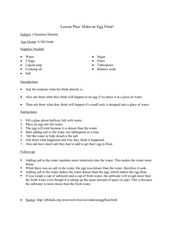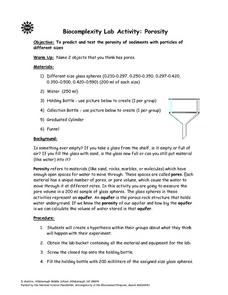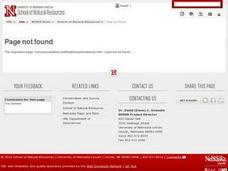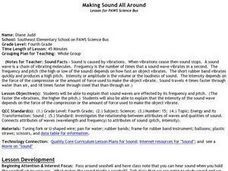Curated OER
Noise Underwater
Sixth graders predict with reasoning how a sound will be heard underwater and record and communicate their findings. They listen to the difference in the way noise sounds underwater verses out of water and relate this to how whales and...
Curated OER
Make An Egg Float!
Students analyze density. In this density lesson, students experiment with floating an egg. Students discover that salt added to water changes the density of the water allowing an egg to float.
Curated OER
Osmosis
Learners explore diffusion and active transport. They observe the effects of eggs in vinegar and predict what will happen when eggs are placed in corn syrup with food coloring. Students complete worksheets which lead them to describe...
Curated OER
Balancing Chemical Equations
Ninth graders explain how atoms and molecules form different substances during chemical reactions and how these processes require losing, gaining or sharing electrons. They correctly write chemical formulas and show how a balanced...
Curated OER
Porosity
Students predict and test the porosity of sediments with particles of different sizes. They name two objects that they think has pores. Students define the term porosity and pores. They comprehend that an aquifer is the porous rock...
Curated OER
Thermal Energy and Heat Unit
Young scholars explain that heat energy in a material consists of the disordered motions of its atoms or molecules. They know and explain that transformations of energy usually transform some energy into the form of heat, which...
Curated OER
From Vibration to Sound
Students observe a series of demonstrations to illustrate wave movement. In this sound wave instructional activity, students witness how objects create waves when dropped in a dish of water, use a rope and slinky to produce transverse...
Curated OER
Make A Crystal Snowflake!
Students make a crystal snowflake decoration out of string, pipe cleaners, food coloring, boiling water, and more. In this snowflake lesson plan, students let it dry over night and see crystals in the morning.
Curated OER
Earth's Atmosphere and Temperature
Students explore the layers of earth's atmosphere and conduct an experiment to identify carbon dioxide. They construct models using styrofoam to represent molecules in the atmosphere's layers. To discover how sunlight efffects...
Curated OER
COMPARISON OF FOUR-, SIX-, AND EIGHT-bp CUTS IN CALF THYMUS DNA
Students use this laboratory exercise, restriction enzymes to recognize a four-, six-, and eight-nucleotide sequence. Assuming that the four component nucleotides (A, C, T, G) are distributed randomly within a DNA molecule, then any...
Curated OER
Heat And Heat Transfer
Students role play molecules in a container as the container is heated to develop a definition of heat and temperature. They also observe demonstrations of conduction, convection, radiation, and phase transfer. Using these observations...
Curated OER
Making Sound All Around
Fourth graders examine how sound waves are effected by frequency and pitch. They conduct experiments using tuning forks, rubber bands, balloons, and water, and answer questions about the experiments.
Curated OER
Make a Bouncy Custard Ball
In this science experiment worksheet, students mix borax, custard powder (pudding mix?), glue and water to make a bouncy ball. Students carry out bouncing and stretching investigations.
Curated OER
Hydrated Salt
Learners plan, design, and carry out an experiment to determine an empirical formula for a hydrated salt X that tell students when all the water has been removed from hydrate crystals.
Curated OER
How Can we Measure the Rate of a Chemical Reaction?
Students examine different types of chemical reactions. They explore how alcohol molecules affect the reaction rates. They answer discussion questions to end the lesson.
Curated OER
Causal Patterns in Density Phenomena
Young scholars investigate the relationship between volume and mass in different liquids such as vegetable oil, rubbing alcohol and water. They measure the mass of several different volumes of each liquid and then graph the results as...
Curated OER
Nutrition
In this health worksheet, students find the words that are related to the breakdown of molecules in food for energy. The answers are found at the bottom of the page.
Curated OER
Nutrition and Energy Flow
In this energy flow worksheet, students will complete 10 short answer questions based on a food web diagram. Then students will review different cycles in nature including the water cycle, carbon cycle, and energy cycle. This worksheet...
Curated OER
Matter and Molecular Motion
Fourth graders define the states of matter and their properties. They demonstrate the air is matter and observe the effect of molecular motion through these activities.
Curated OER
Chemistry: Chemical Reaction
In this chemical reactions worksheet, students name the reactants and products, balance the equation, calculate the molecular weight of the reactants and products, and classify each reaction type. Students fill in a table of solubility...
Curated OER
Colligative Properties - Freezing Point Depression
In this freezing point worksheet, students determine the freezing point of solutions at different concentrations. This worksheet has 9 problems to solve.
Curated OER
Science: Pigments and Photosynthesis
Young scholars explore the process of photosynthesis by identifying chloroplasts and chlorophyll pigments. In a demonstration, they observe a demonstration connecting pigments with sunlight conversion into energy. Using paper...
Curated OER
Drops on a Penny
Eighth graders experiment to determine the number of drops of water a heads up penny hold. They create a stem and leaf graph of the class results and use the data for further experimentation on a tails up penny.
Other popular searches
- Polar Water Molecules
- Water Molecules Models
- Constructing Water Molecules
- Matter and Molecules Water
- Water Molecules Definitions

























